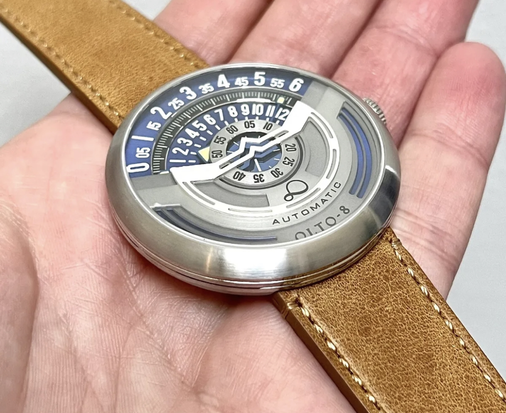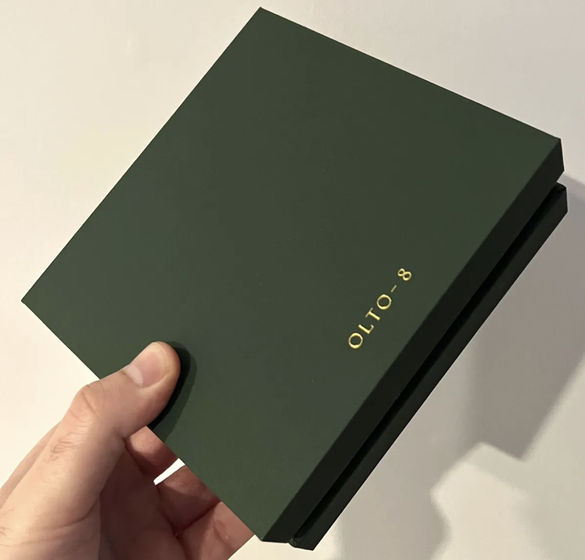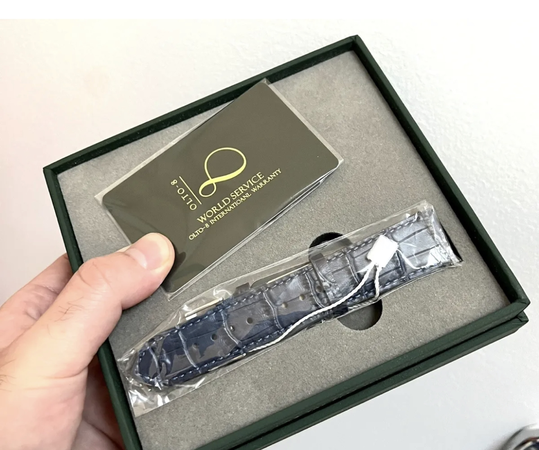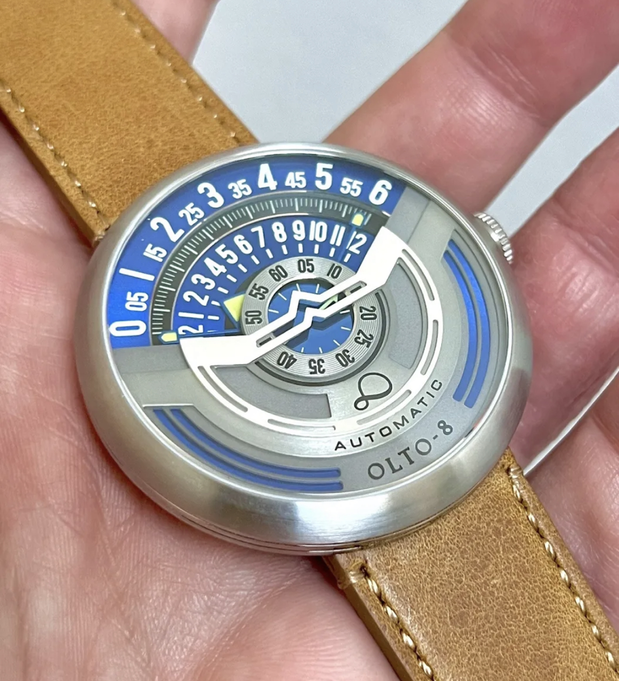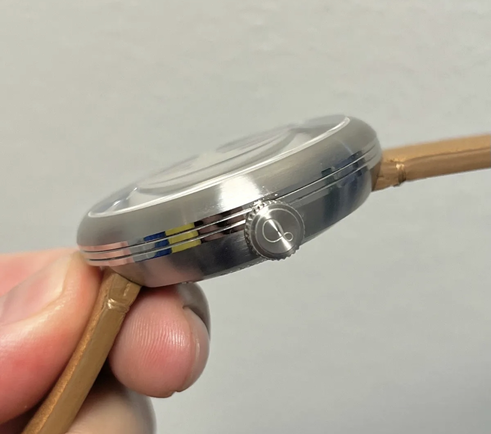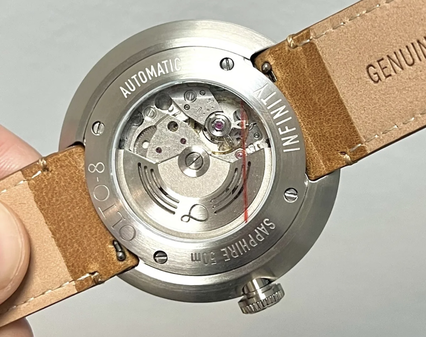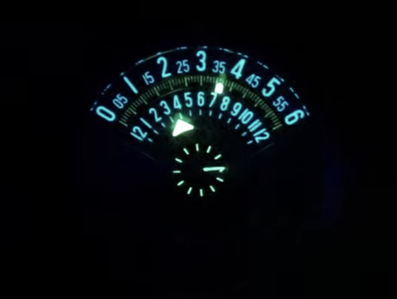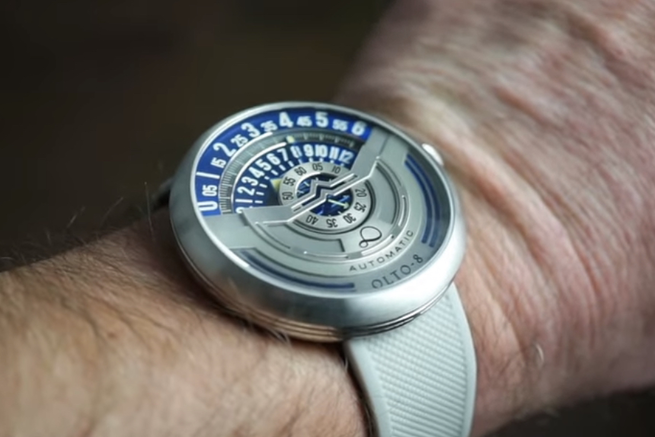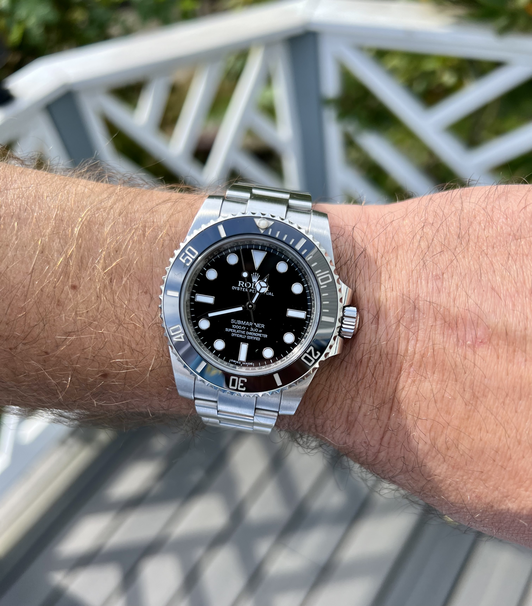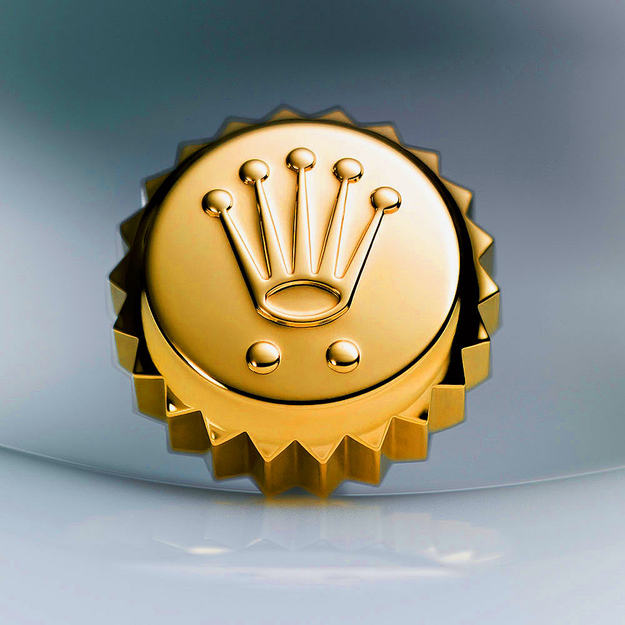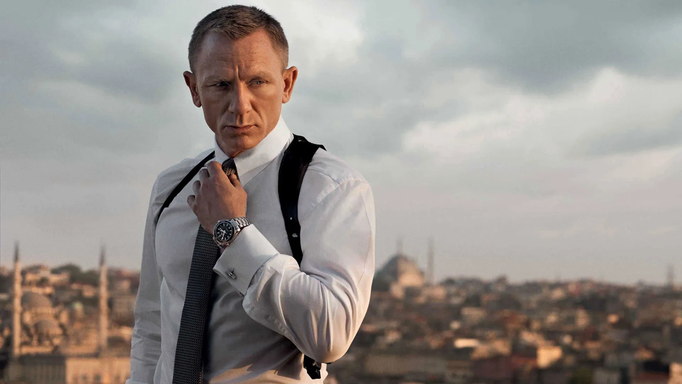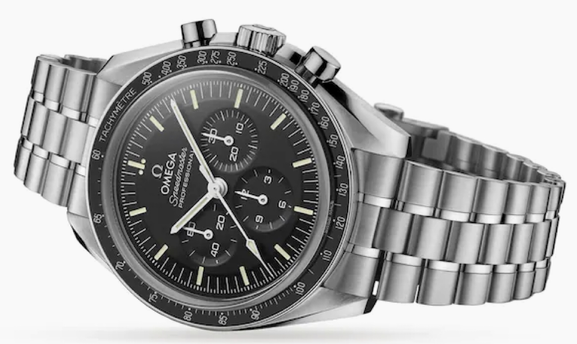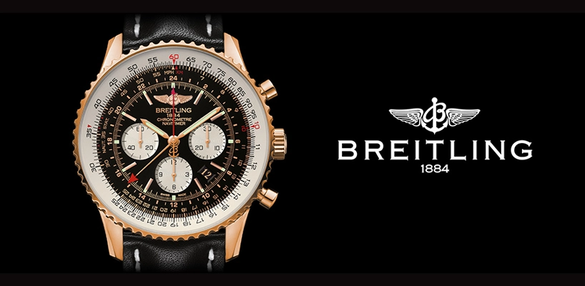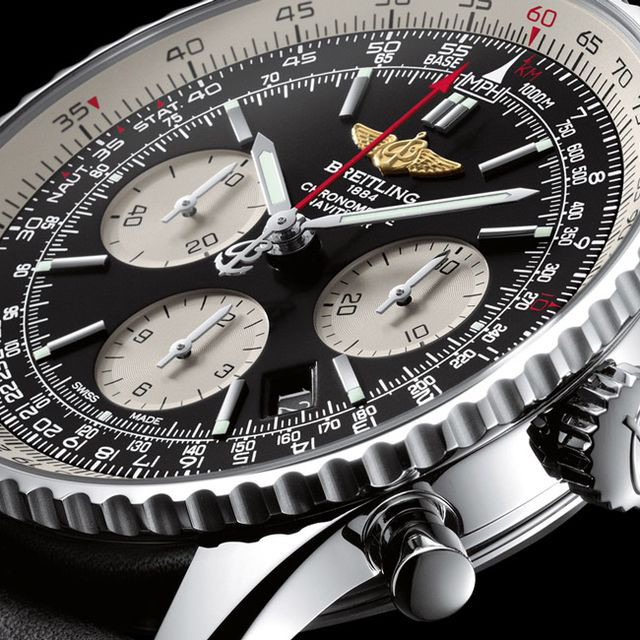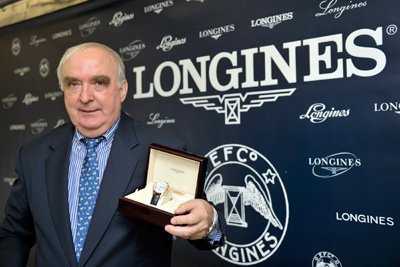PackagingCase and DialThe Olto-8 Infinity 1 comes in a solid circular shaped brushed 316L stainless steel case. The brand introduced this model a couple years back and have been producing innovative and customized watches/movements with interesting ways to tell time. This watch is basically all dial in its Blue variant and features two tracks of numerals to tell the hour and minutes along with a rotating seconds subdiak which is brushed grey to match the outer bottom portion of the dial. A genuine sapphire ar coated crystal covers this dial and allows for very good legibility. In terms of dimensions we are looking at 46MM in diamter and 13.5MM thick which may seem super large but it wears much smaller considering we have a 22MM lugless design. The case itself features a screw down exhibition sapphire caseback with 5ATM of water resistance accompanied by a pull abd push crown. A nice detail is the mix of blue bgw9 and C3 lume on the two hands and all of the numerals, which is not easy task considering the size of them. Overall, its very well finished and near perfect without any sharp edges nor blemishes. MovementThey decided to utilize a Japanese automatic customized Miyota 8215 which features 21 Jewels, handwind, but one downside is the no hacking. It does feature a 42 Hour power reserve and these movements are very tough and robust beating at 21,600 BPH. It is a well tested and tried movement that will last a lifetime with very little room for error. A nice touch is the custom rotor they decided to add to the movement to add some visual interest. Leather BandsThe bands are genuine leather in a tan color along with a blue embossed band which is actually of pretty good quality. They do feature quick release and are fairly easy to swap out on the go. It is nice that the package does include two bands to change up the look of your infinity watch whether youd like to dress it up or down. They are quite supple and do not require a break-in period to be worn comfortably. ConclusionFurthermore, for under $500 on Didamoda - an Olto-8 webshop - I think you are getting something quite unique for your money. It is definitely a custom 1:1 design created by Olto-8 themselves which is something quite odd in todays day and age of smaller watch companies. I must say and have always said this about OLTO-8 - their watches feel very premium and do not feel like a typical microbrand watch or smaller run. Overall, I really like the watch and feel there is a lot here this watch offers the end user for the money. Also , keep in mind all OLTO-8 Timepieces come with a 2 Year Warranty which is another big plus considering most brands now are offering one year warranties.
0 Comments
|
Archives
February 2024
|
ROLEX HISTORY
Rolex is a Swiss luxury watch brand that was founded in 1905 by Hans Wilsdorf and Alfred Davis in London, England. The company originally began as Wilsdorf and Davis, but it was later renamed to Rolex in 1908.
The first Rolex watches were not manufactured in-house, but instead were made by other watchmakers and then branded with the Rolex name. However, Wilsdorf had a vision of creating a wristwatch that was both reliable and accurate, and he set out to develop his own movements.
In 1910, Rolex became the first wristwatch to receive the Swiss Certificate of Chronometric Precision, which was a testament to the accuracy of the watch. Over the years, Rolex continued to innovate and develop new technologies and features, such as the first waterproof wristwatch in 1926, the first self-winding mechanism in 1931, and the first wristwatch with a date display in 1945.
Rolex has also been associated with several famous individuals, including explorers, athletes, and celebrities. For example, Sir Edmund Hillary and Tenzing Norgay wore Rolex watches when they became the first people to reach the summit of Mount Everest in 1953. Rolex has also been the official timekeeper of several sporting events, including Wimbledon and the Formula 1 Grand Prix.
Today, Rolex is one of the most recognized and respected luxury watch brands in the world, known for its quality, precision, and timeless style.
The first Rolex watches were not manufactured in-house, but instead were made by other watchmakers and then branded with the Rolex name. However, Wilsdorf had a vision of creating a wristwatch that was both reliable and accurate, and he set out to develop his own movements.
In 1910, Rolex became the first wristwatch to receive the Swiss Certificate of Chronometric Precision, which was a testament to the accuracy of the watch. Over the years, Rolex continued to innovate and develop new technologies and features, such as the first waterproof wristwatch in 1926, the first self-winding mechanism in 1931, and the first wristwatch with a date display in 1945.
Rolex has also been associated with several famous individuals, including explorers, athletes, and celebrities. For example, Sir Edmund Hillary and Tenzing Norgay wore Rolex watches when they became the first people to reach the summit of Mount Everest in 1953. Rolex has also been the official timekeeper of several sporting events, including Wimbledon and the Formula 1 Grand Prix.
Today, Rolex is one of the most recognized and respected luxury watch brands in the world, known for its quality, precision, and timeless style.
OMEGA Watches History
Omega is a Swiss luxury watch brand founded in 1848 by Louis Brandt in La Chaux-de-Fonds, Switzerland. The brand initially operated under the name La Generale Watch Co. and produced pocket watches.
In 1894, Omega revolutionized the watch industry with the introduction of the 19-ligne Omega Calibre, which was more accurate and reliable than any other watch movement of the time. This innovation earned Omega numerous awards and accolades, and the brand quickly became known for its precision and quality.
In 1903, Omega was chosen as the official timekeeper for the Gordon Bennett Cup, an international balloon race. This marked the beginning of Omega's long-standing relationship with sports timing and its reputation as a reliable and accurate timekeeper.
In 1932, Omega became the first brand to be awarded the Olympic Cross of Merit for its outstanding contribution to sports timing at the Olympic Games. Since then, Omega has been the official timekeeper for numerous Olympic Games, and its timekeeping technology has continued to evolve and improve.
In the 1950s and 1960s, Omega's watches were worn by famous explorers and adventurers, including Sir Edmund Hillary and Tenzing Norgay during their ascent of Mount Everest in 1953, and Jacques Cousteau during his underwater expeditions.
In the 1960s, Omega introduced the Speedmaster, a chronograph watch that was originally designed for motorsports but became famous as the first watch worn on the moon during the Apollo 11 mission in 1969. The Speedmaster has since become one of Omega's most iconic and sought-after models.
Today, Omega continues to innovate and produce high-quality watches, including the Seamaster, Constellation, and De Ville collections. The brand also continues to be the official timekeeper for numerous sporting events, including the Olympic Games and the America's Cup.
In 1894, Omega revolutionized the watch industry with the introduction of the 19-ligne Omega Calibre, which was more accurate and reliable than any other watch movement of the time. This innovation earned Omega numerous awards and accolades, and the brand quickly became known for its precision and quality.
In 1903, Omega was chosen as the official timekeeper for the Gordon Bennett Cup, an international balloon race. This marked the beginning of Omega's long-standing relationship with sports timing and its reputation as a reliable and accurate timekeeper.
In 1932, Omega became the first brand to be awarded the Olympic Cross of Merit for its outstanding contribution to sports timing at the Olympic Games. Since then, Omega has been the official timekeeper for numerous Olympic Games, and its timekeeping technology has continued to evolve and improve.
In the 1950s and 1960s, Omega's watches were worn by famous explorers and adventurers, including Sir Edmund Hillary and Tenzing Norgay during their ascent of Mount Everest in 1953, and Jacques Cousteau during his underwater expeditions.
In the 1960s, Omega introduced the Speedmaster, a chronograph watch that was originally designed for motorsports but became famous as the first watch worn on the moon during the Apollo 11 mission in 1969. The Speedmaster has since become one of Omega's most iconic and sought-after models.
Today, Omega continues to innovate and produce high-quality watches, including the Seamaster, Constellation, and De Ville collections. The brand also continues to be the official timekeeper for numerous sporting events, including the Olympic Games and the America's Cup.
BREITLING Watches History
Breitling is a Swiss luxury watch brand that was founded in 1884 by Léon Breitling in the town of Saint-Imier in the Canton of Bern, Switzerland. Initially, the company specialized in producing chronographs and other precision timepieces for scientific and industrial purposes.
In 1915, Breitling introduced the first wrist-worn chronograph with a separate pusher to control the start, stop, and reset functions, which made it easier to use than previous models. This innovation helped establish Breitling as a leading maker of chronographs and other precision timepieces.
During the 1930s and 1940s, Breitling continued to innovate with the introduction of the first chronograph with a second independent pusher, which allowed for the recording of multiple elapsed times. The company also developed the Huit Aviation Department, which produced wristwatches for pilots and other aviation professionals.
In the 1950s, Breitling introduced the Navitimer, a wristwatch with a built-in slide rule that allowed pilots to perform complex calculations in-flight. The Navitimer became an instant classic and remains one of Breitling's most popular models to this day.
In the 1960s, Breitling continued to produce innovative timepieces, including the Chrono-Matic, which was the first automatic chronograph movement with a micro-rotor. The company also introduced the Emergency, a wristwatch with a built-in distress beacon that could be activated in case of an emergency.
In the years since, Breitling has continued to produce innovative and high-quality timepieces for a variety of applications, including aviation, diving, and sports. The company has also maintained a strong commitment to precision and accuracy, with many of its watches featuring COSC-certified movements. Today, Breitling is recognized as one of the world's leading luxury watch brands, with a reputation for innovation, quality, and style.
In 1915, Breitling introduced the first wrist-worn chronograph with a separate pusher to control the start, stop, and reset functions, which made it easier to use than previous models. This innovation helped establish Breitling as a leading maker of chronographs and other precision timepieces.
During the 1930s and 1940s, Breitling continued to innovate with the introduction of the first chronograph with a second independent pusher, which allowed for the recording of multiple elapsed times. The company also developed the Huit Aviation Department, which produced wristwatches for pilots and other aviation professionals.
In the 1950s, Breitling introduced the Navitimer, a wristwatch with a built-in slide rule that allowed pilots to perform complex calculations in-flight. The Navitimer became an instant classic and remains one of Breitling's most popular models to this day.
In the 1960s, Breitling continued to produce innovative timepieces, including the Chrono-Matic, which was the first automatic chronograph movement with a micro-rotor. The company also introduced the Emergency, a wristwatch with a built-in distress beacon that could be activated in case of an emergency.
In the years since, Breitling has continued to produce innovative and high-quality timepieces for a variety of applications, including aviation, diving, and sports. The company has also maintained a strong commitment to precision and accuracy, with many of its watches featuring COSC-certified movements. Today, Breitling is recognized as one of the world's leading luxury watch brands, with a reputation for innovation, quality, and style.
Longines
Longines is a Swiss luxury watch company that was founded in 1832 by Auguste Agassiz in the town of Saint-Imier, Switzerland. The company has a long and prestigious history in the world of watchmaking, and has been responsible for many innovations and milestones in the industry.
In the early days, Longines primarily produced pocket watches, and quickly gained a reputation for precision and accuracy. By the end of the 19th century, Longines had become one of the leading watchmakers in the world. In 1912, the company introduced the first chronograph wristwatch, which was quickly adopted by the military and aviation communities.
In the 1920s and 1930s, Longines continued to innovate with the introduction of the world's first quartz clock and the first wristwatch with an automatic winding mechanism. During World War II, Longines produced wristwatches for the British Royal Air Force, and continued to produce military watches for several decades afterwards.
In the post-war years, Longines became known for its elegant and sophisticated watches, particularly its "Conquest" line of watches. In the 1950s and 1960s, Longines was a favorite of celebrities and politicians, and its watches were frequently seen on the wrists of Elvis Presley, John F. Kennedy, and other famous figures.
In recent years, Longines has continued to produce high-quality watches that combine traditional Swiss craftsmanship with modern technology. The company is particularly known for its sport watches, including its "HydroConquest" line of diving watches and its "Conquest Classic" line of chronographs.
Today, Longines is owned by the Swatch Group, and remains a leading brand in the luxury watch industry. Its watches are prized for their precision, reliability, and timeless style.
In the early days, Longines primarily produced pocket watches, and quickly gained a reputation for precision and accuracy. By the end of the 19th century, Longines had become one of the leading watchmakers in the world. In 1912, the company introduced the first chronograph wristwatch, which was quickly adopted by the military and aviation communities.
In the 1920s and 1930s, Longines continued to innovate with the introduction of the world's first quartz clock and the first wristwatch with an automatic winding mechanism. During World War II, Longines produced wristwatches for the British Royal Air Force, and continued to produce military watches for several decades afterwards.
In the post-war years, Longines became known for its elegant and sophisticated watches, particularly its "Conquest" line of watches. In the 1950s and 1960s, Longines was a favorite of celebrities and politicians, and its watches were frequently seen on the wrists of Elvis Presley, John F. Kennedy, and other famous figures.
In recent years, Longines has continued to produce high-quality watches that combine traditional Swiss craftsmanship with modern technology. The company is particularly known for its sport watches, including its "HydroConquest" line of diving watches and its "Conquest Classic" line of chronographs.
Today, Longines is owned by the Swatch Group, and remains a leading brand in the luxury watch industry. Its watches are prized for their precision, reliability, and timeless style.
Tissot
Tissot is a Swiss watch brand that was founded in 1853 by Charles-Félicien Tissot and his son Charles-Émile Tissot in the town of Le Locle, Switzerland. The company has a long and rich history in the world of watchmaking, and has been responsible for many innovations and milestones in the industry.
In the early days, Tissot primarily produced pocket watches, and quickly gained a reputation for quality and precision. By the end of the 19th century, Tissot was one of the largest watchmakers in Switzerland, and was exporting its watches to countries around the world.
In the early 20th century, Tissot continued to innovate with the introduction of the first non-magnetic wristwatch, the first dual time-zone watch, and the first watch with a plastic case. During World War II, Tissot produced watches for the Allied forces, and continued to produce military watches for several decades afterwards.
In the post-war years, Tissot became known for its elegant and sophisticated watches, particularly its "Tissot Visodate" line of watches, which featured a date function and a distinctive "T" logo on the dial. In the 1970s, Tissot was one of the first Swiss watch brands to introduce quartz watches, which quickly became popular due to their accuracy and affordability.
In recent years, Tissot has continued to produce high-quality watches that combine traditional Swiss craftsmanship with modern technology. The company is particularly known for its sport watches, including its "T-Touch" line of watches, which feature touch-screen technology and a range of functions such as altimeter, compass, and thermometer.
Today, Tissot is part of the Swatch Group, and remains a leading brand in the watch industry. Its watches are prized for their quality, durability, and stylish design, and are worn by watch enthusiasts and collectors around the world.
In the early days, Tissot primarily produced pocket watches, and quickly gained a reputation for quality and precision. By the end of the 19th century, Tissot was one of the largest watchmakers in Switzerland, and was exporting its watches to countries around the world.
In the early 20th century, Tissot continued to innovate with the introduction of the first non-magnetic wristwatch, the first dual time-zone watch, and the first watch with a plastic case. During World War II, Tissot produced watches for the Allied forces, and continued to produce military watches for several decades afterwards.
In the post-war years, Tissot became known for its elegant and sophisticated watches, particularly its "Tissot Visodate" line of watches, which featured a date function and a distinctive "T" logo on the dial. In the 1970s, Tissot was one of the first Swiss watch brands to introduce quartz watches, which quickly became popular due to their accuracy and affordability.
In recent years, Tissot has continued to produce high-quality watches that combine traditional Swiss craftsmanship with modern technology. The company is particularly known for its sport watches, including its "T-Touch" line of watches, which feature touch-screen technology and a range of functions such as altimeter, compass, and thermometer.
Today, Tissot is part of the Swatch Group, and remains a leading brand in the watch industry. Its watches are prized for their quality, durability, and stylish design, and are worn by watch enthusiasts and collectors around the world.


